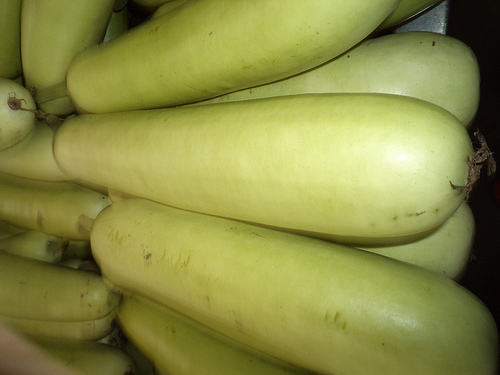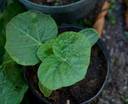Upo or bottle gourd belongs to the family CuCurbitaceae and is adapted to the dry tropics. Optimum temperature for good growth ranges 18 degree Celsius to 24 degree Celsius. It can be seed produced anytime of the year as long as water is available. Upo is a short day plant, a cool and long nights favor the development of more female flowers. For greater yield, it is best to plant when flowering coincide with the long, cool nights of November to January and for harvesting to fall on the dry months of the year.
Cultural Management

Land Preparation. Land Preparation can be done mechanically or with the use of animal-drawn implements. Prepare land thoroughly, making sure to breakdown bid clods of soil. Space the furrows 75 cm apart.
Planting. Upo is usually direct seeded and requires 2 kg seeds/ hectares. Space the plants 0.75m-1.0m between hills and 2.25-3m in between rows. Plant 2-3 seeds per hill and cover with a thin layer of soil.
Fertilization. The rate of fertilization depends on soil analysis, but in its absence, apply 15 g or 1.5 tablespoons (tbsp) complete fertilizer (14-14-14) per hill before planting. Cover the fertilizer with a thin layer of soil. Add a handful of well decomposed manure. At early vining stage or a month after sowing, sidedress 20 20 g of a mixture of 2 parts Urea (46-0-0) and one part Muriate of potash (0-0-60).
Thinning. Two to three (2-3) weeks after planting, thin out weak seedlings leaving behind one healthy plant per hill.
 Irrigation. Irrigate immediately after planting to ensure uniform seed germination. During the dry months, furrow irrigate every 10 days. Irrigate only when necessary during the wet season. Construct drainage canals at the end of the rows to avoid flooding especially during wet season.
Irrigation. Irrigate immediately after planting to ensure uniform seed germination. During the dry months, furrow irrigate every 10 days. Irrigate only when necessary during the wet season. Construct drainage canals at the end of the rows to avoid flooding especially during wet season.
Weeding.. Thoroughly hand wed the planted rows. Underbrush or rotavate the large spacing in between rows.
Trellising. Trellising us essential to during wet season when rotting of fruits may occur resulting in poor seed quality. Trellising during dry season is optional. Construct an overhead trellis. Layout 2 m long, 2-2.5 diameter poles at the top along the rows with wire (#16) and tie the top wire to a posted stake at the end of the row to stabilize the poles.
Connect the poles between rows with wire and connect to a posted stake at the last row. Construct the overhead trellis by running alternately wires and straws lengthwise and crosswise at the top of trellis. Construct a structure for the vines to climb on.
Insect pest management. Yellow squash beetle is the most destructive pest during the first 3 weeks of growth. Control them with appropriate pesticide. Other pests include caterpillars and leaf eating insects. Avoid spraying late in the afternoon. Upo flowers open late in the afternoon and spraying at this time may kill the pollinators.
Disease Management.. Anthracnose is the most prevalent disease of upo. Control the spread of the disease by spraying with fungicides and cutting off diseased plant parts immediately.
Pollination/Isolation. Upo is predominantly a cross-pollinated crop and readily crosses with other varieties. Maintain an isolation distance of at least 500 m for certified seeds and 1600 m for foundation seeds. Flowers open late in the afternoon and stay open throughout the night. Nocturnal and diurnal insects mainly pollinate the flowers.
Field Inspection/ Roguing. Inspect the seed crops regularly and remove off types when seen. At vegetative stage, inspect for leaf size, shape, color, vigor and vine trailing habits. At flowering and immature fruit stage, check shape and color of ovaries, fruit shape, color and general appearance. when fruits mature, check for fruit shape, size and color.
Harvesting. Harvest the fruits when they turn pale yellow. At early fruit maturity, the fruits tend to be heavy, but they lose weight as they reach full maturity which is about 90 days from planting. Fruits can be harvested and stored for 1 month before seed extraction to allow the seeds to mature further.
POSTHARVEST HANDLING
Seed Processing. Cut fruits in halves or section and scoop out the seeds from the pulp. Put extracted seeds in a pail of water and allow white immature seeds together with flayed pulp to float on water surface. Pour out the water with the immature seeds and dirt, leaving the normal seeds at the bottom of the pail. Repeat the procedure until seeds are clean. Put clean seeds in a net bag or spread thinly on jute sacks. Air dry for 2-3 days. Gradually sundry the seeds for 4-5 days to lower moisture content before packaging. Seed yield: 100-300 kg/ha.


